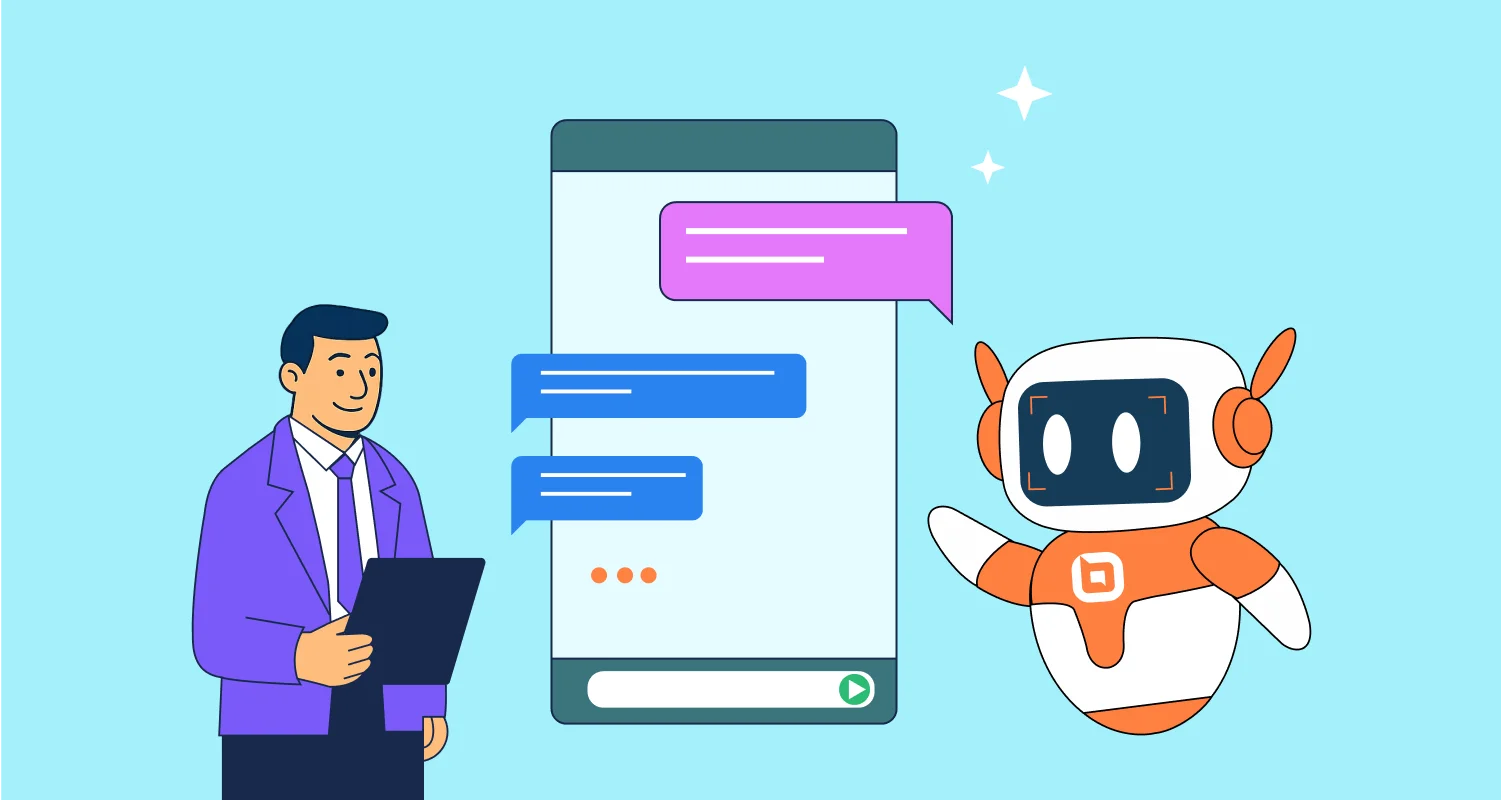What if every customer interaction felt natural, intelligent, and highly helpful, no matter the time or channel?
That’s the promise of conversational AI for customer service. A technology that enables businesses to engage in dynamic, context-aware conversations with customers at scale.
By understanding intent, remembering context, and delivering intelligent, personalized responses, conversational AI is transforming how brands communicate with their customers.
Top companies are now leveraging this innovation to provide seamless, 24/7 customer service that responds in real time and learns from each interaction to improve future engagements.
But what makes conversational AI for customer service so transformative, and why are leading brands accelerating their investment in it?
In this blog, we’ll discuss what a conversational AI for customer service is and why it matters in today’s customer-first business landscape.
What is a conversational AI?
Conversational AI refers to a set of artificial intelligence technologies that understand and provide responses to both text and voice commands in a human-like manner.
It uses natural language processing (NLP) and machine learning (ML) to interpret user intent, recognize tone, and maintain context throughout a conversation.
In customer service, conversational AI is used to automate and enhance support by handling tasks like answering product questions, assisting with account issues, etc.
With 68% of businesses already using conversational AI for customer service, the technology is becoming a standard tool for enhancing support, positioning companies that adopt it early at a significant competitive advantage.
Benefits of conversational AI for customer service
Conversational AI for customer service has revolutionized how businesses interact with their customers in different ways. Below are some of the key benefits of having one.
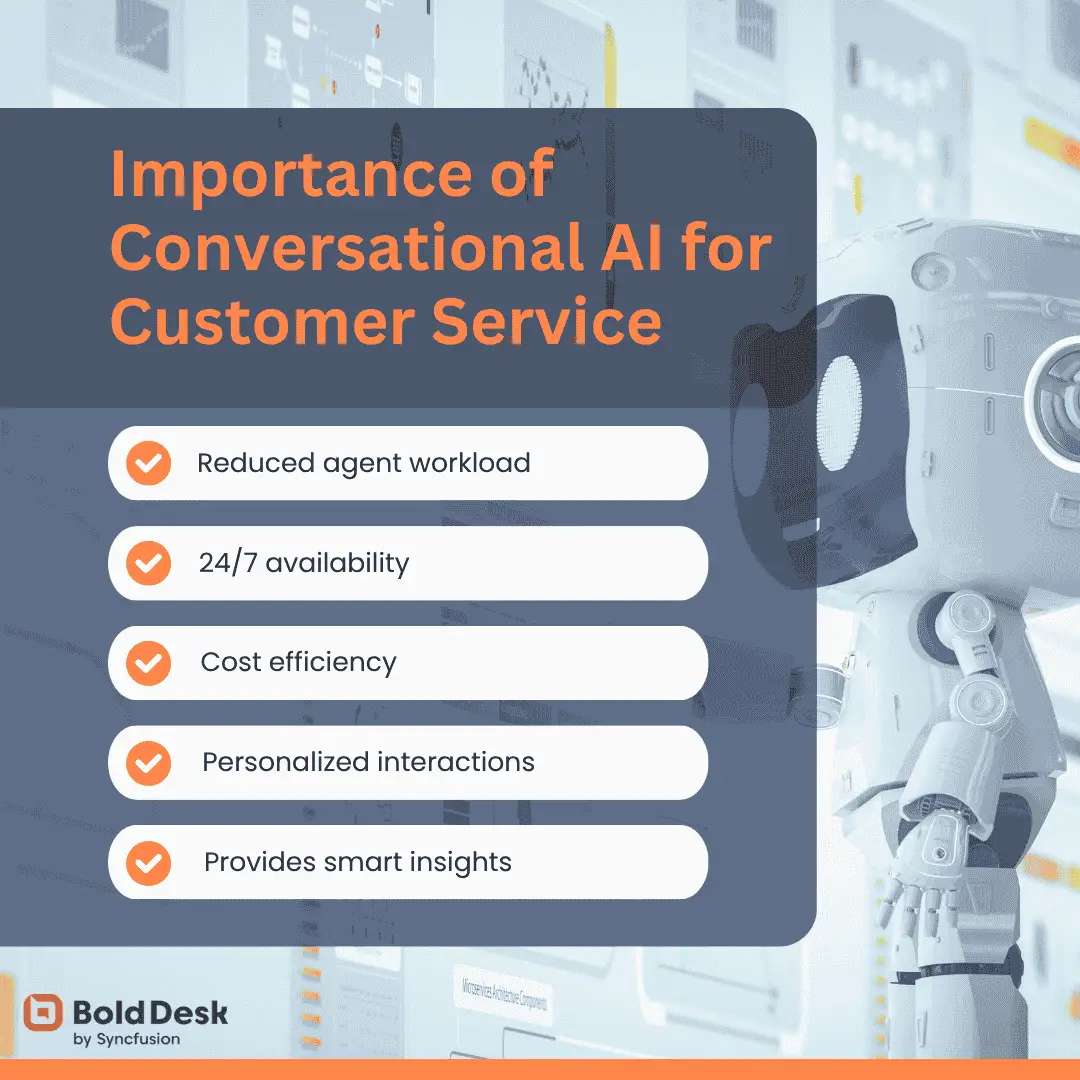
Reduced agent workload
Conversational AI handles repetitive tasks like answering FAQs or checking order status. This frees up human agents to focus on complex or emotional issues where empathy matters most.
Instead of answering customer questions such as “What’s your return policy?” 100 times a day, agents can help an angry customer resolve a delayed shipment.
24/7 availability
Conversational AI never sleeps! As such, it provides round-the-clock support, ensuring customers receive assistance regardless of business hours, time zones, weekends, or holidays.
Cost efficiency
By automating routine queries and tasks, businesses can reduce the need for large customer support teams. This lowers operational costs while maintaining high customer service levels.
Personalized interactions
Conversational AI uses data from CRM systems, purchase history, and past customer interactions to deliver personalized customer service. It maintains context across sessions and offers tailored recommendations, which makes customers feel heard and valued.
Provides smart insights
The conversational AI tools analyze interactions to spot trends, common issues, and customer pain points. This helps companies to refine the conversational AI platform performance, improve products, or optimize service strategies.
For instance, if many customers ask about a confusing feature, the company can update the product or improve the user manual.
Types of conversational AI in customer service
As digital transformation continues to reshape industries, businesses are rethinking how they engage with customers.
Around 80% of business leaders report noticeable improvements in customer satisfaction, service speed, and contact center performance after adopting conversational AI tools.
But what are these tools? Here’s a breakdown of the main types:
- AI agents
- AI copilot
- Voice-based AI interface
- Chatbot
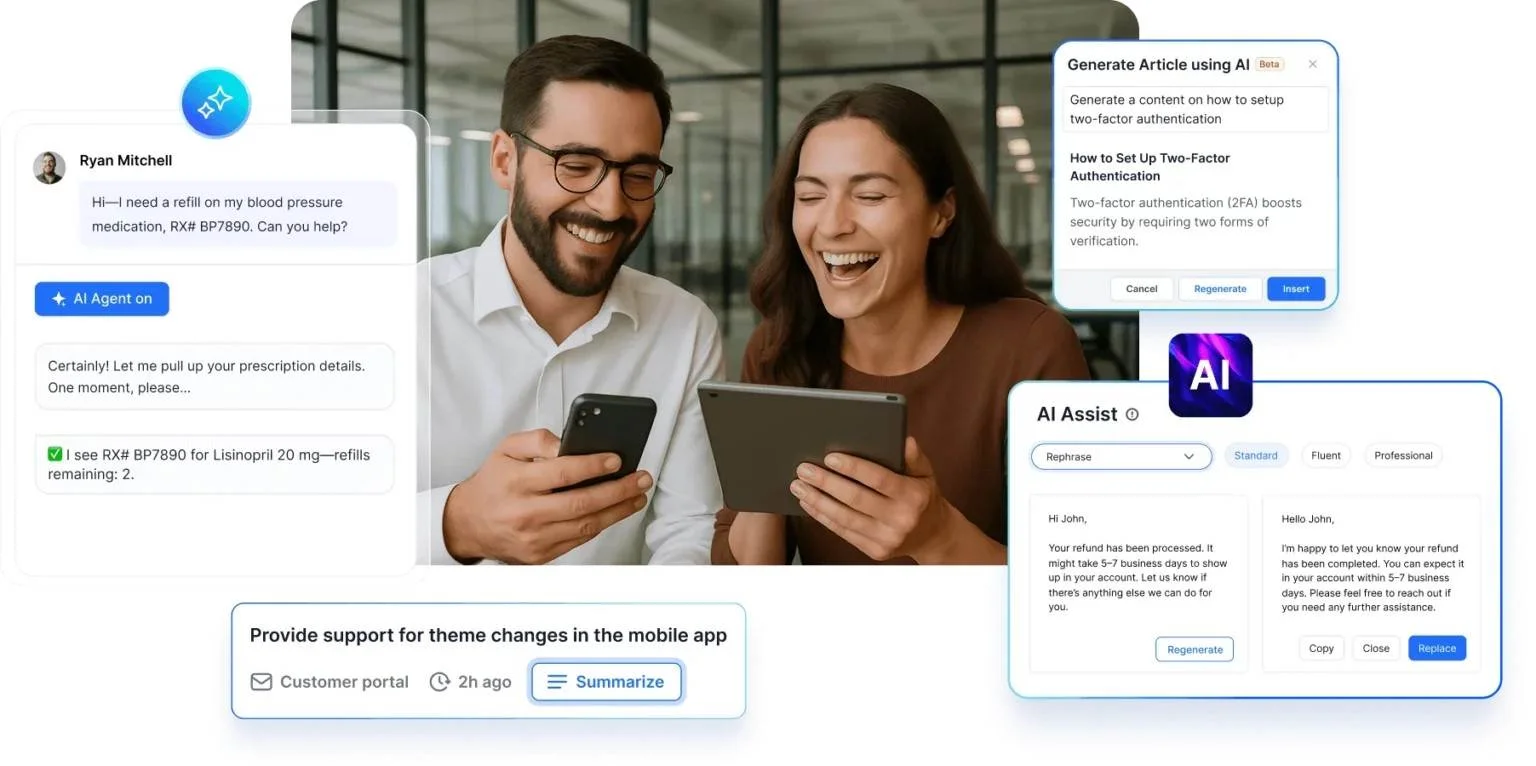
AI agents
Also referred to as virtual assistants, AI agents are advanced conversational AI tools designed to independently manage entire customer interactions from initial contact to resolution without human intervention.
Key functions of AI agents include:
- Engage in dynamic, context-aware conversations by engaging like humans.
- Recognize their environment, reason, and take appropriate actions.
- Operate across multiple communication channels, e.g., email and tickets simultaneously.
- Maintain context across sessions and integrate with business systems like CRMs.
- Improve by learning from past interactions with users.
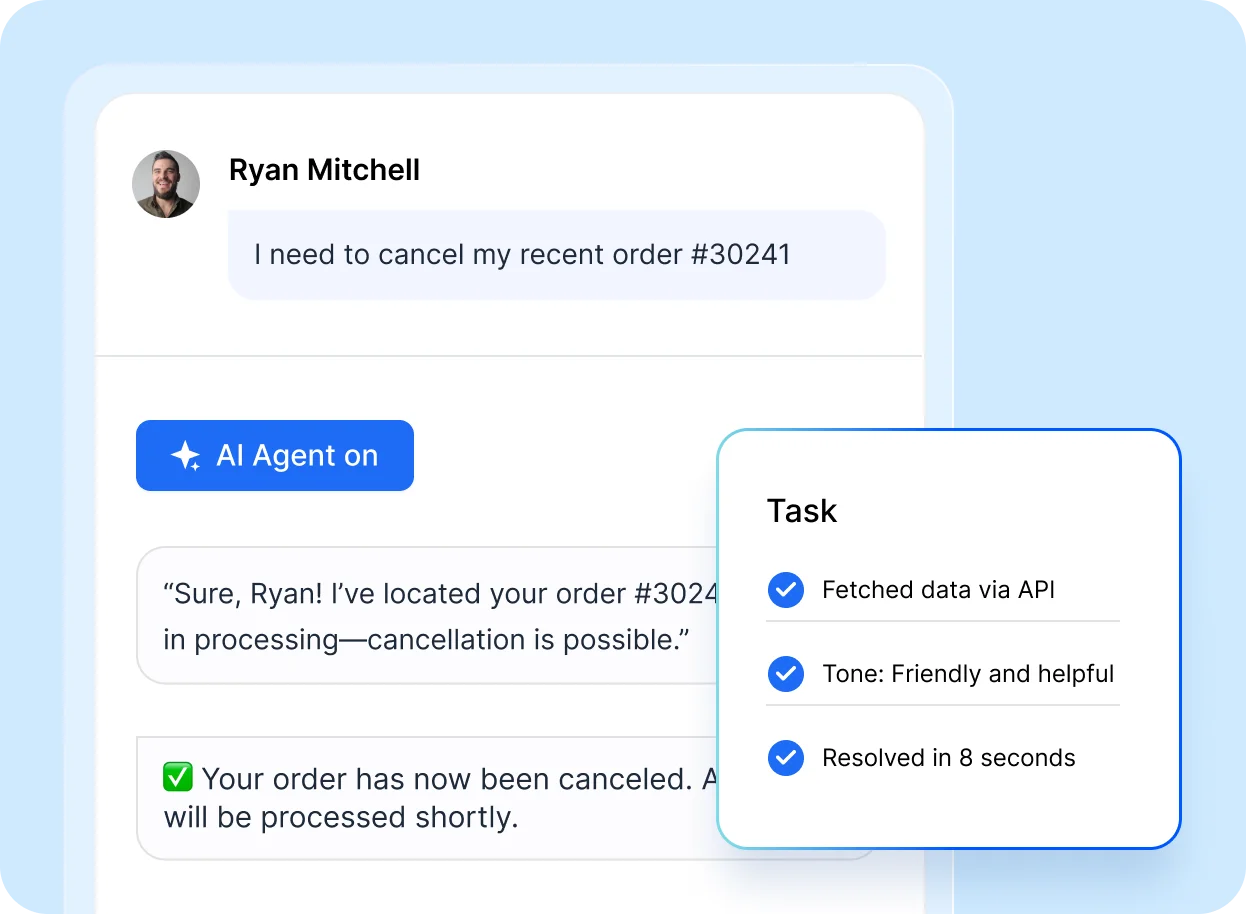
AI copilot
An AI Copilot is a real-time conversational assistant that supports human agents by enhancing productivity and decision-making during live interactions.
It integrates with existing tools such as knowledge bases or ticketing systems to provide intelligent, context-sensitive support.
Key functions of the AI copilot include:
- Suggest smart and relevant responses from conversations and knowledge base.
- Summarize, rephrase, and translate messages during conversations.
- Auto-fill ticket fields based on conversation content.
Voice-based AI interfaces
These are voice-driven conversational AI systems that enable users to interact with technology using spoken language.
They include:
- Voice assistants: Use speech recognition, NLP, and text-to-speech to carry out tasks, answer questions, and control devices via voice, e.g., Amazon Alexa.
- Interactive Voice Response (IVR) systems: Automate phone-based interactions using voice or keypad inputs to route calls or provide information.
Chatbots
Chatbots are conversational AI tools designed to simulate human-like interactions, often used in customer service to provide instant support.
They rely on predefined rules and scripts to interpret user inputs and provide responses.
As such, they are often task-specific and designed for narrow use cases such as:
- Answering frequently asked questions.
- Guiding users through a website.
- Automating customer service interactions.
Common industry use cases of conversational AI in customer service
Conversational AI is transforming customer service by automating interactions, improving efficiency, and enhancing user experiences.
Below are common use cases where conversational AI is effectively deployed in customer service:
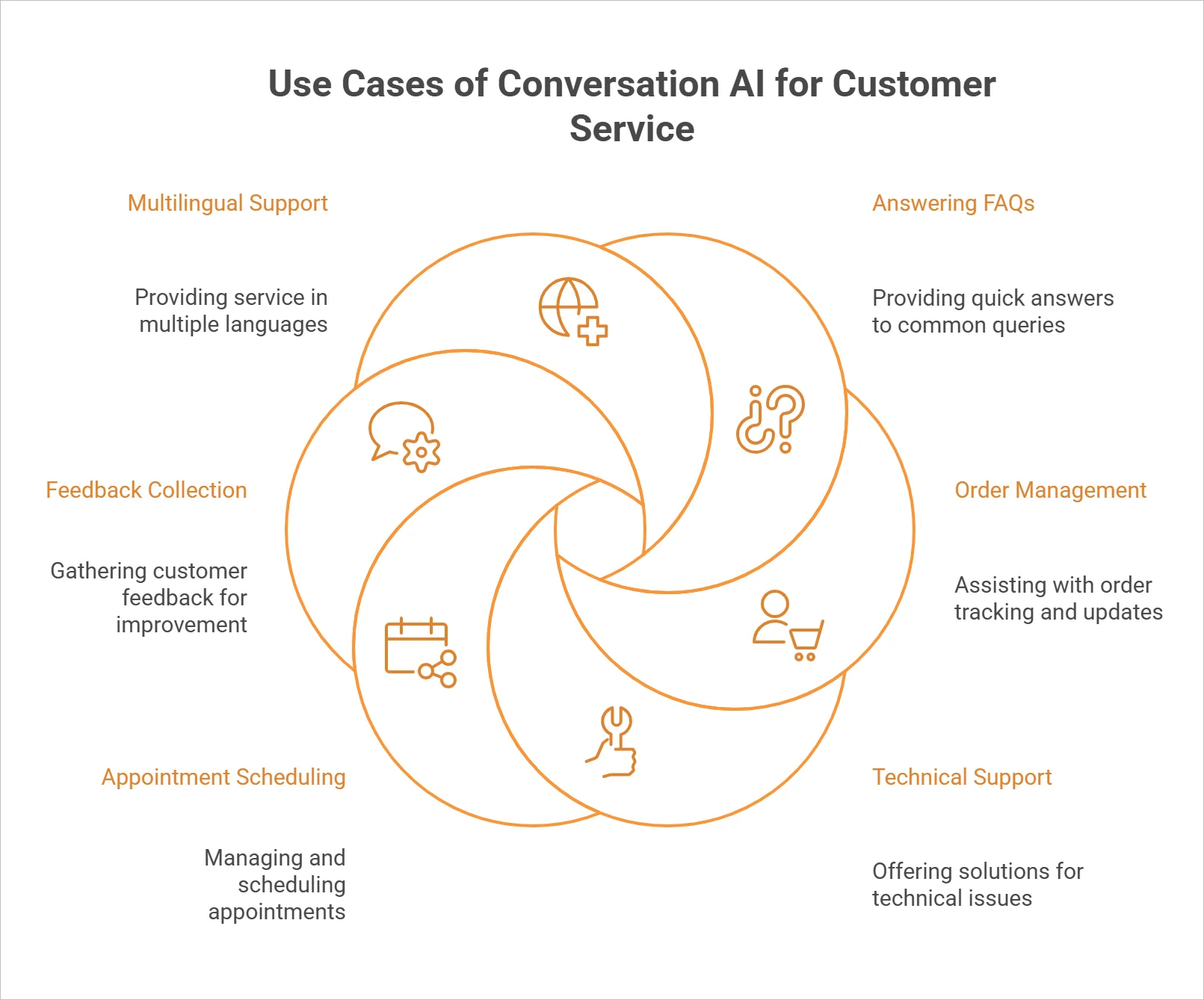
Handling frequently asked questions (FAQs)
Conversational AI can obtain relevant company information from their knowledge base software and customer interactions to recognize and respond to common questions.
This can be done using predefined or dynamically generated answers.
Example
Warby Parker, an eyewear company, uses conversational AI to answer frequent eyewear questions by pulling information from its knowledge base. This enables it deliver accurate, personalized responses through their website or app.
Order management
Conversational AI for customer support can be used to retrieve and update order information by integrating it with a business’ inventory and logistics systems.
This allows users to confirm order status, change delivery details, or cancel orders through the conversational AI tools.
Example
The online food delivery service, DoorDash, utilizes a conversational AI tool that integrates with its logistics and inventory systems to handle customer orders.
It provides real-time delivery updates, allows changes or cancellations, and uses sentiment analysis to flag issues for human review, ensuring smooth order resolution.
Technical support and troubleshooting
Conversational AI for service uses intent recognition to guide customers through diagnostic steps, asking clarifying questions, and providing instructions based on known issue-resolution workflows.
Example
BoldDesk’s AI Agent handles queries from multiple channels, offering step-by-step guidance and automating tasks like password resets.
Integrated with ticketing and knowledge base systems, it resolves issues without human intervention, quickly summarizes ticket histories, and can be customized for tone and style, ensuring efficient, brand-consistent support.
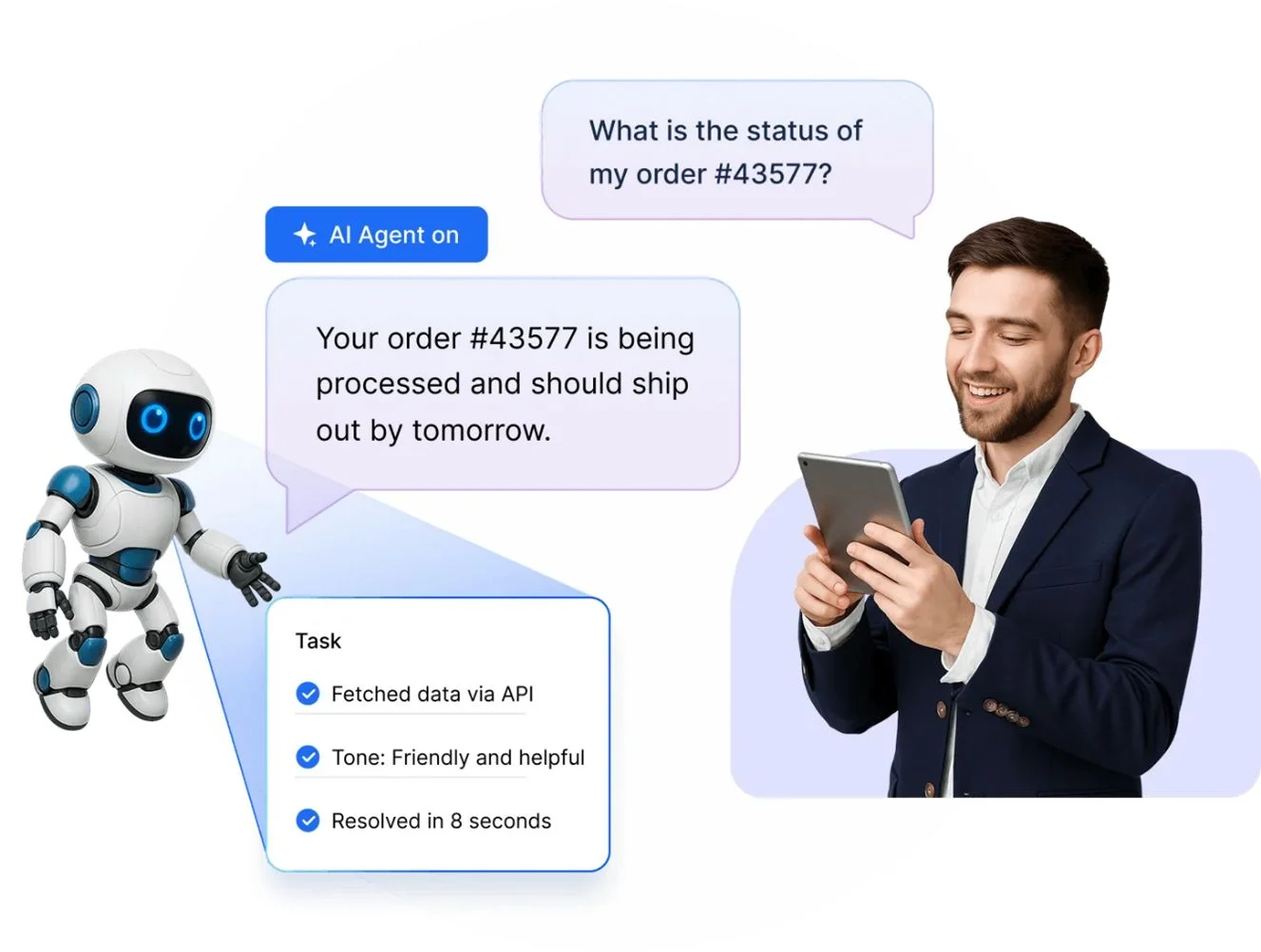
Appointment scheduling
By connecting to calendar and booking systems, conversational AI manages appointment slots, confirms availability, and processes scheduling, rescheduling, or cancellation requests through conversational prompts.
Example
Delta Airlines, through its conversational AI-powered Delta Concierge, helps customers by checking itineraries and real-time flight data to suggest and confirm appointment changes, sends updates, and offers proactive alerts like visa or gate information.
This enhances travel planning with minimal human help.
Feedback collection
The conversational AI can initiate structured or open-ended feedback sessions after transactions or interactions with customers, capturing user input through conversational forms and storing responses for analysis.
Example
Airbnb, an online marketplace for house rentals, uses a conversational AI software to gather post-stay feedback through its messaging platform using natural language processing to ask guests about their experience.
It analyzes and categorizes responses for hosts and Airbnb’s quality team, linking feedback to specific stays to support improvements and enhance future guest experiences.
Multilingual support
Conversational AI detects and processes multiple languages using multilingual NLP models, enabling it to understand and respond appropriately in the user’s preferred language.
Example
TransferGo, an authorised electronic money institution, uses a multilingual virtual agent to handle real-time customer requests. Integrated with account systems, it performs tasks like updating user details or checking transfers in the customer’s language, ensuring culturally accurate responses.
This reduces reliance on human agents while maintaining high-quality global service.
Best practices for adopting conversational AI for customer service
The successful implementation of conversational AI technologies goes beyond simply deploying them, it requires thoughtful planning, transparency, and continuous optimization.
Here are some best practices that organizations should follow to ensure their conversational AI for customer service strategies deliver real value while maintaining trust and efficiency.
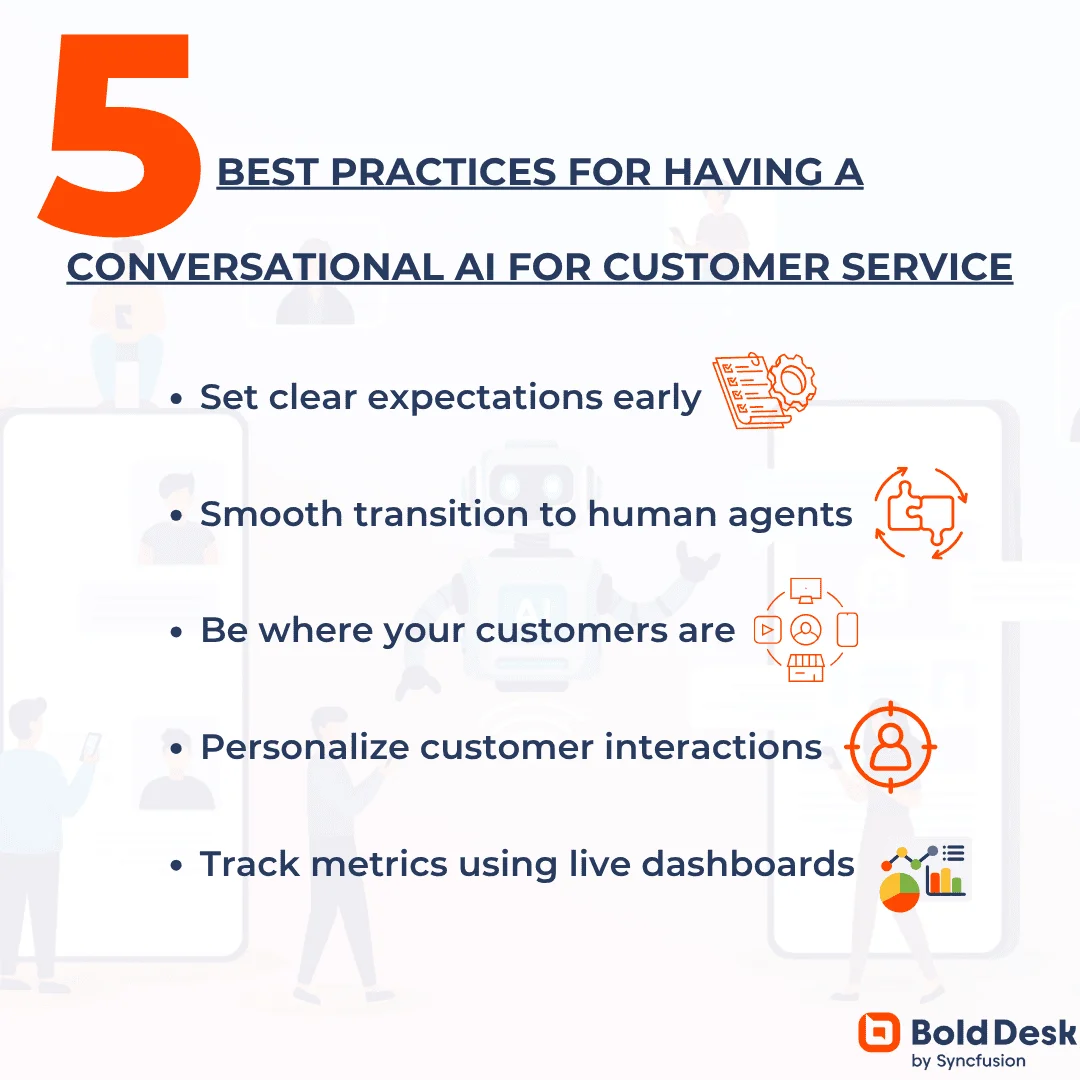
Set clear expectations early
Customers don’t like surprises, especially when they’re trying to solve a problem. Let them know up front that they’re talking to AI and clearly define what it can and can’t do.
You can do this with a user-friendly opening message that matches your brand style.
For example:
“Welcome, [Name]! I’m your AI virtual assistant for today. I can check your order status or answer product questions. What’s up?”
This builds trust and avoids frustration when the conversational AI hits its limits and needs to hand over to a human.
Truth is, when customers understand what the conversational AI can and can’t do, they’re more forgiving when it hits a wall and more appreciative when it gets things right.
Ensure a smooth conversational AI transition to human agents
Complex problems like a billing mix-up or emotional moments, such as when a customer is upset about a delayed order, need a human touch. Even the smartest AI can’t handle everything.
A seamless transition from the conversational AI platform to a human agent ensures customers feel heard, not shuffled around.
Moreover, the conversational AI should pass along all relevant context and history from the interaction so the agent can continue the conversation without delays or repetition.
Be where your customers are
Your customers are everywhere, be it WhatsApp, Instagram, email, live chat, you name it.
Consequently, your conversational AI needs to be there too, delivering a consistent omnichannel customer experience across all channels.
To implement the conversational AI effectively, consider the following pro tips:
- Start by identifying where your customers are already engaging with you the most.
- Map out these preferred communication channels to understand where your audience feels most comfortable and where they’re most likely to interact.
- Prioritize those high-traffic channels when introducing your conversational AI.
By focusing on the platforms your customers already use, you’ll not only meet them where they are but also maximize the impact and effectiveness of your conversational AI from the beginning.
Personalize interactions and match brand tone
According to Forbes, 81% of customers prefer companies that offer personalized experiences.
Additionally, 70% value interactions where employees recognize them and understand their history with the company, including past purchases and support interactions.
Your conversational AI should be able to understand user intent, recall past interactions, and tailor responses accordingly.
Whether your brand is formal, friendly, or playful, consistency in communication helps reinforce brand identity and makes interactions more authentic.
Track AI metrics using live dashboards
To ensure your conversational AI delivers consistent value in customer service, it’s essential to track performance metrics continuously.
The live dashboards, such as AI conversation report, enable businesses to handle the following:
- Monitor conversational AI performance metrics live, including ticket volume, resolution rates, etc.
- Visualize customer interactions and agent handoffs to identify where the AI is succeeding or needs improvement.
- Customize dashboards with drag-and-drop widgets to focus on the metrics that matter most.
- Share dashboards across cross-functional teams to align goals and ensure everyone has access to up-to-date insights.
Live dashboards provide real-time visibility into how your conversational AI for customer service is performing, allowing teams to quickly identify issues, optimize workflows, and adapt to customer needs.
Pairing these live dashboards with automated alerts and trend analysis ensures your conversational AI evolves with your business and customer expectations.
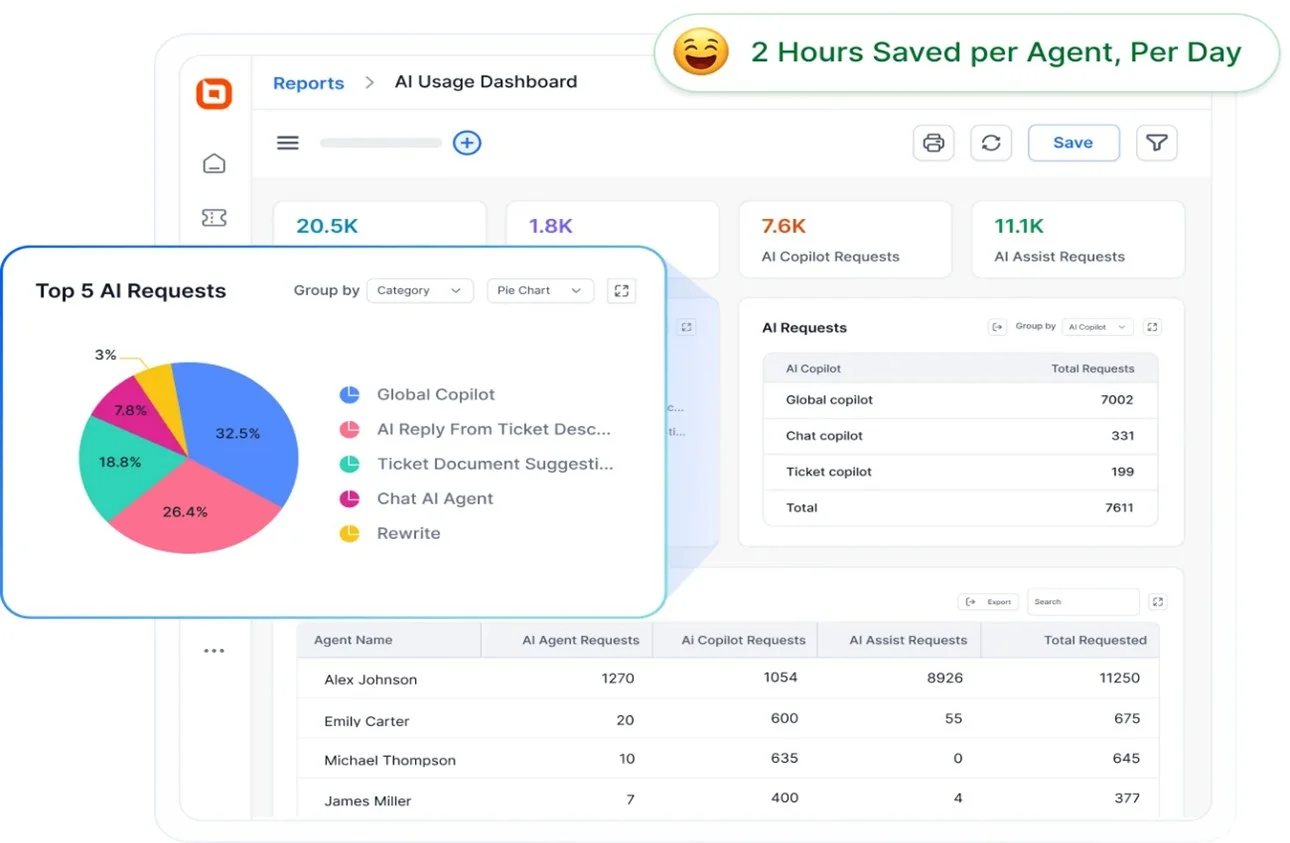
Scale human-like support with conversational AI for customer service
Conversational AI for customer service is not just a tool; it’s a bridge between human empathy and digital efficiency.
It understands natural language and remembers past interactions, turning every interaction into a moment of prosperity.
BoldDesk offers powerful conversational AI tools like AI Agent and AI Copilot, which automate up to 40% of customer queries and generate multilingual brand-aligned responses.
It also provides smart suggestions from your knowledge base, helping support teams respond faster and boost customer satisfaction.
Contact our support team to know more about BoldDesk. Finally, let us know what you think in the comments section below.
Related articles
- 13 Types of Customer Service and Support Models for Success
- From AI to Personalization: 15 Customer Service Trends to Watch in 2025
Frequently asked questions
The main difference is that a chatbot follows rigid rules like a script, answering only what it’s programmed for, while conversational AI understands context and meaning, letting you have a natural, back-and-forth conversation.
Generative AI creates entirely new content, such as articles, images, or emails, by drawing on patterns it has learned. In contrast, conversational AI is designed to engage in natural dialogues, responding dynamically to user input in a way that feels human and intuitive.
Training conversational AI begins with learning from real customer interactions like chat transcripts which help it recognize common questions and concerns.
The AI is first taught general language skills, then fine-tuned with customer service-specific data so it can respond accurately and empathetically.
Customer feedback plays a crucial role in shaping its tone and improving the quality of its responses. Over time, the AI continues to evolve, learning from new interactions to stay relevant and effective.
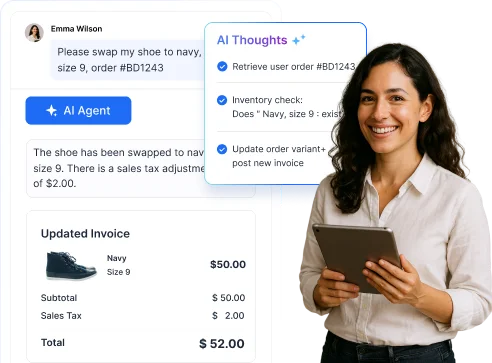


















 Email Ticketing System
Email Ticketing System Shared Inbox Software
Shared Inbox Software Multi Brand Help Desk
Multi Brand Help Desk Internal Help Desk Software
Internal Help Desk Software Trouble Ticketing Software
Trouble Ticketing Software Mobile Help Desk
Mobile Help Desk 









